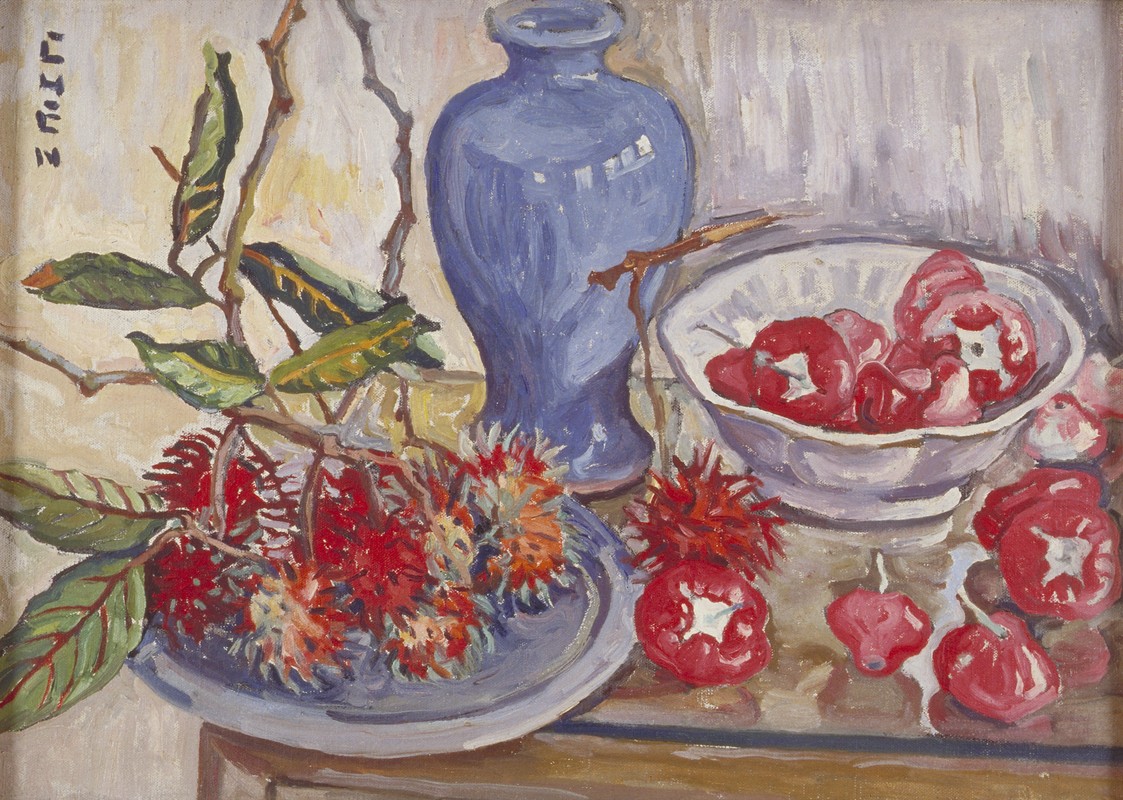先驱画家:沈雁
沈雁(1919-2010)是新加坡20世纪先驱艺术家,为新加坡现代美术发展贡献良多。生于中国浙江一个富裕家庭,她曾在上海美术专科学校学习美术与音乐,后于新华艺术专科学校进修,直至1938年毕业。由于当时的艺专都教授中西两种系统的美术,沈雁同时接受了中国水墨画和西方油画的培训。
在上海成功举办个展后,沈雁于1949年前往东京日本大学艺术学部深造。她于1952年毕业后前往巴黎,并在接下来的两年内大量创作。除了在法国现代艺术家法朗雷全(1881-1955)的画室研习,她也趁此机会周游欧洲,游历意大利、西班牙等地。她有五幅画作于1953年入选法国国家美术协会沙龙画展,巴黎市博物馆还购入了其中一幅。1954年,她首次在新加坡举办展览,获得不错的回响。新加坡色彩缤纷的景致、人们的好客、并且此地有旧识(昔日在上海结识的老师刘抗和学生黄葆芳当时都在新加坡),让沈雁最终决定定居落户于此,从此展开绘画、展览、旅行、教学皆不误的充实生活。1
美术实践方面,沈雁与新加坡许多同行一样,喜欢露天绘画。这是他们之前在中国艺专培训中所看重的,即绘画需仔细观察现实世界,并将它准确描绘出来。2所以,沈雁的许多画作描绘了不少大家熟悉的本地主题,如新加坡的热带花卉和多元种族的人物景象。

中西传统
沈雁在中西绘画的基础,让她无论是油彩或水墨,都挥洒自如,她的展览也往往展出油画和水墨画作品。这样的情况,也和当时定居在新加坡、出生于中国的艺术家,如陈文希、锺四宾等相同。沈雁和他们一样,觉得中西美术传统之间并无矛盾,融合两者有其价值。她坚信崭新的“马来西亚化”的美术应该与时并进,在形式和内容上将西方美术的科学技巧与中国美术的传统与精神融为一体。3

沈雁在创作水墨画时,通常以写意为主,强调主观表达而非客观描绘。然而,在一些如《印度舞蹈》的人物画中,沈雁打破传统,细细描绘舞者的身形和面部表情,并注入西方写实主义对光影的探索,将人物定格在跳舞的瞬间,犹如照片瞬间拍下的一景。

尽管她的早期作品以大胆著称,沈雁的油画创作,还是以自然主义风格为主。在1950年代,刘抗(1911-2004)便称她的风格为“野兽派”。这在她引人注目的画作《巴黎艳舞》(1965)中可见一斑。画中人物被涂成粉色、绿色、蓝色等相异且不协调的色彩。4然而,除了在1970年代短暂尝试在铝板上作画之外,沈雁的风格并非以大胆著称,也未像锺四宾(1917-1983)和陈文希(1906-1991)那样,经常实验各种西方现代美术形式,比如立体主义或抽象艺术。总体而言,沈雁虽信奉中西艺术融合,但这在她的大部分作品中并未充分展现。

虽然如此,沈雁无疑是新加坡艺坛重要的美术教育家。在中国学会的支持下,她创办了新加坡艺术学院(Singapore Academy of the Arts)5,并任院长近30年,这是新加坡女性艺术家中的首例。中国学会于1949年在新加坡成立,旨在推动对中国文化的兴趣和欣赏。学会的活动包罗万象,如刊物出版、音乐会、讲座和艺术展览,而其中就包括1957年在新加坡艺术学院名下开设的艺术课程。沈雁从1950年代中期到1980年代在任期间,该学院培养了许多学生,其中有人后续赴海外深造,并成为了知名艺术家。6学院当时受到学子的欢迎,吸引了大量无法全职学习,只能在傍晚或周末上课的学生。可惜因为后来面临财务问题,又一直没有专属校地,学院最终在1980年代关闭。随着学院的关闭,沈雁在也在1990年代渐渐淡出艺坛。作为一名美术教育家,沈雁谦卑大度,关爱学生,备受尊敬。7她终身未婚,可到了晚年,姚天佑等昔日学生自动自发地照顾这位恩师,直到她于2010年去世为止。
本文原文为 Pioneer artist: Sun Yee,此为编辑和翻译后的版本。点击此处查看原文。
| 1 | 〈沈雁女士赴暹展画〉,《南洋商报》,1955年9月9日。 |
| 2 | 传统上,中国水墨画是通过临摹前辈艺术家和经典作品来进行教学的。20世纪初期,中国与西方和日本的接触日益增多,从而出现了偏向西方式教学方法的艺术院校。这些院校注重绘画能力,强调透视、光影和准确描绘。常见的教学方法包括裸体研究和写生。参见:Ralph Crozier, “Post Impressionists in pre-War Shanghai: The Juelanshe (Storm Society) and the Fate of Modernism in Republican China”, in Modernity in Asian Art (Australia: Wild Peony Limited, 1993), 136; Kao Meiching, “The Quest for New Art”, in Twentieth Century Chinese Painting (New York: Oxford University Press, 1988), 130. |
| 3 | 沈雁,〈从东西艺术谈到如何创造马来西亚化艺术〉,收入氏著,《艺坛风云》(香港:田风印刷厂,1966),页21。 |
| 4 | 刘抗表示,“沈女士的画,到目前为止,大体上是属于后期印象派这个范畴的,笔力矫健,设色浓郁,取材尤为别致,处处显出刚毅之态势。几幅荷花,气魄雄浑,胆力过人,实际上已是野兽派的作为。”参见:刘抗,〈沈雁的艺术〉(1948),收入《刘抗文集》(新加坡教育出版社,1981),页22-23。画作《巴黎艳舞》,参见沈雁展览目录《沈雁画集》(新加坡:沈雁,1997),页30。 |
| 5 | 并非创办于2004年的新加坡艺术学院(School of the Arts Singapore)。 |
| 6 | 其中包括安曼(Inche Yunos bin Aman)、杨锦成与黄光彩。 |
| 7 | 沈雁与昔日学生林辉忠曾同时参加一场本地艺术比赛,结果林辉忠获奖,沈雁却名落孙山。沈雁虽资历较长,却毫无架子,在颁奖典礼上大方地恭贺林辉忠,让他深受感动。(与林辉忠访谈,2022年12月30日)另一回,沈雁允许学生童振狮将学院昂贵的石膏像带回家自习素描,让他很是惊喜。(与童振狮访谈,2023年1月5日)。 |
Low, Sze Wee. “Who are the Nanyang women artists?”. ThinkChina, 26 May 2023. | |
沈雁,《艺坛风云》。香港田风印刷厂,1966。 |










